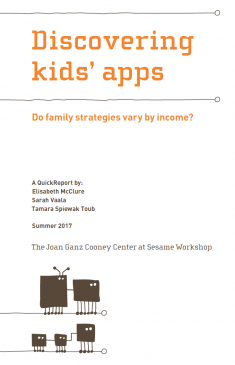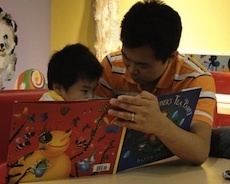Judging a book by more than its cover: Exploring features of traditional and e-book reading experiences that support children’s learning
July 26, 2017

Photo: Flickr/ Svanke Ademark
Imagine: a young child looks up at an adult expectantly and hands them a book. It’s hard to say no to a simple request like that, so the adult settles down next to the child and dives into the story.
When we break this adult-child book-reading interaction down, there are many elements that vary. For example:
- The physical proximity and orientation of the adult and child. Is the child sitting in the adult’s lap? Are they next to each other at a table? Are they cuddling?
- The order and timing of pages read. First to last, without stopping? Flipping back and forth between pages to look at or remember something? Getting interrupted or losing interest and finishing a while later, if at all?
- The volume, pitch, and animation of the adult’s voice. Is it constant? Varied based on characters or plot points? Or different based on the child’s engagement?
- The content of what the adult says. Does the adult simply read the text within the book’s pages? Are there added questions or comments about the story? Questions or comments about other things? Responses to the child’s questions, comments, or behaviors?
- The child’s behavior and engagement. Is the child listening quietly? Looking at the book or at the adult? Touching the book? Talking with the adult? Distracted by other things?
And that’s just the start!
Many of these elements of the reading experience have been identified as important for facilitating children’s development. When reading with children, we introduce them to the written word, to symbolism and narratives, as well as key academic and social concepts and thought processes. We help build the foundation for literacy and for learning.
Our society encourages parents and caregivers to read with children starting in infancy. We have programs like Reach Out and Read, in which pediatricians and nurses distribute books at well-child visits and discuss the importance of reading aloud with families. We have libraries and book stores filled with paperbacks and hardcover books. And we have app stores filled with e-books.
Which leads to many questions, like: Are e-books better or worse for children than traditional books? Which features of traditional adult-child book-reading interactions are mimicked well with digital media? And, as researchers identify key features of book-reading that promote children’s learning, how can we best design and utilize digital media to incorporate those features?
QuickReports produced by the Cooney Center in 2012 were among early investigations about how parent-child interactions using print books compare to their interactions using e-books and how parents view these different reading opportunities. The research community has continued to delve deep into such topics in the years since then, and recent data contributes to the expanding conversation. At the annual meeting of the Jean Piaget Society in early June, I was part of a symposium (organized by Dr. Brenna Hassinger-Das, Dr. Rebecca Dore, and Dr. Roberta M. Golinkoff) devoted to the topic of making evidence-based decisions about children’s digital media. My presentation was on how science might better inform parent’s selection processes. Then, three of the other speakers presented new research about children’s experiences with e-books, in particular, and how different features of e-books contribute to those experiences.
Dr. Brenna Hassinger-Das and colleagues set out to explore how children’s experiences with e-books compare to their experiences with traditional books, especially given the confusing combination of earlier studies showing differences in some cases but not others. Breaking down the category of e-books further, they examined different features of e-books by comparing “unembellished e-books” (digitized versions of traditional books), “audio e-books” (with an automated read-aloud feature), and “activities e-books” (with interactive activities). Eighty-six parents and their 3- or 4-year-old children participated in the study. Pairs were randomly assigned to one of the four types of books and parents were instructed to “read the book as you normally would.” Hassinger-Das’s team focused specifically on the type of talk that parents used during book-reading and on the children’s comprehension of the story. They found that parents used similar amounts of some types of talk no matter which type of book they were reading. For example, they used the same amount of factual talk (e.g., “There are two bears in this picture”), regardless of book type.
But some types of talk were more prevalent with certain types of books. For example, parents reading the audio e-book used more “distancing talk” than parents reading the activities e-book. Distancing talk includes questions and comments that connect an element of the story to children’s experiences, moving beyond the story itself to something in their lives, such as, “We saw a bear at the zoo yesterday!” Many researchers have identified distancing talk as a key part of adult-child book-reading that supports literacy development. Importantly, in this study, when researchers asked children questions about the book’s story, children’s accuracy did not depend on which type of book they were read, but their answers tended to be better if their parent used a lot of distancing talk.
The take-away: when it came to story comprehension, how parents talked to their children remained an important element of the book-reading experience while the type of book was less important.
In the next study, Dr. Rebecca Dore and her colleagues wondered if children could gain as much from independent use of an audio e-book as they did from having their parent read the e-book with them. This is a particularly relevant question, as many families are embracing digital media as a tool to keep children entertained, engaged, and educated while adults accomplish other daily tasks. Does the audio feature of an e-book provide comparable support for children?
Almost 140 children ages 4-5 years participated in the study, either reading an e-book with their parent, using an e-book independently with the audio feature reading to them, or reading an e-book without the audio feature. Results showed that children’s abilities to retell the story and answer comprehension questions were the strongest when a parent read with them. The independent experience was not as good for supporting these narrative skills. However, having the audio feature on helped children to do better than when the audio feature was not available. The study found that independent e-book use with automated narration can indeed support children’s comprehension of the story, although it is not as helpful as parent narration.

All images, dialogue, and audio © Fred Rogers Company & Vanderbilt University/University of South Dakota
Peg + Cat © 2016 Feline Features, LLC
These findings suggest that the design of e-books has important implications for how well they can support children’s learning. Since we know that features of live adult-child interactions are important contributors to children’s development during book-reading, we need to find ways to incorporate similar features and strategies into the design of e-books. Dr. Gorgene Troseth and her colleagues have taken on this challenge with the Fred Rogers Company, with an eye toward using e-books as a tool to help support the type of distancing talk that facilitates children’s development. They limited the features of e-books that researchers have found often interfere with learning, and augmented the multi-media elements that tend to support the text of the story.
The team also created an avatar named Ramone, who pops up on the screen periodically to model and encourage the types of questions and comments that adults can ask while reading the book with children. With an initial sample of almost 50 children ages 3-4 years and their parents, Troseth’s team has started to compare parents’ talk while they’re reading a version of the e-book that doesn’t have Ramone to parents’ talk when they’re reading with Ramone’s assistance. While parents without Ramone used about 220 words, parents with Ramone used over 830 words.
These early findings suggest that building evidence-based features into digital apps can help increase the types of behaviors that best support children’s learning from apps. Ideally, developers can apply similar approaches to the design of apps that children use independently, so the benefits of adult-child reading can be even better mirrored when children’s partners are digital.
When Dr. Jennifer Zosh presented her thoughts at the June symposium, she challenged attendees to think about how to integrate parents more strategically within digital parenting resources. With book-reading, in particular, research tells us that there are key ingredients to the success of a parent (or any adult) reading to a child. Of course, which ingredients are key depends in part on what the learning goals are as well as other considerations about the family, including the age of the child.
While the symposium research focused mostly on preschoolers, a recent news story announced, “Electronic books captured the attention of toddlers and led to greater learning” than paper versions of the books, based on research published in Frontiers about toddlers’ ability to learn new animal names during book-reading. It is essential to address these key questions about e-books’ relative benefits across the developmental spectrum as we strive to best leverage the technology literally at our fingertips.
Although it can be hard for research to keep up with the pace of technological advances, it is important to create strong networks of collaboration and communication among researchers, app designers and developers, and the families and educators helping to shape children’s digital lives. And that is one of the reasons I have been so excited and honored to join the Cooney Center community in these efforts. It serves us all well to take what science knows about effective book-reading practices and apply it to the creation of e-books for children to use with—or without—adults. And by studying the effectiveness of digital media designs, we can continue to tweak until we get various features—the tapping, swiping, voices, animations, etc.—working in children’s favor to keep them (and the adults who care for them) engaged, learning, and engaged in learning.
 Tamara Spiewak Toub earned her Ph.D. in developmental psychology at the University of Washington and completed a postdoctoral fellowship with Dr. Kathy Hirsh-Pasek at the Temple University Infant and Child Lab, where she remains involved in ongoing research. Broadly, Tamara is interested in the promotion of children’s development through playful and other common activities and in the translation of research findings to application in children’s lives. Her research has focused on families’ navigation of educational apps for young children, pretend play and executive function skills, the use of games and other play-based approaches to supporting preschoolers’ vocabulary development, and developmental benefits of theater involvement for typically-developing individuals and those on the autism spectrum. Beyond the lab, Tamara consults on the designs of museum exhibits, curricula for educators, and child-oriented community events. Given existing gaps between common practices and science-based guidance, Tamara also leads professional development workshops and writes for general audiences to communicate findings from the learning and developmental sciences to the families, educators, and policy-makers affecting children’s lives.
Tamara Spiewak Toub earned her Ph.D. in developmental psychology at the University of Washington and completed a postdoctoral fellowship with Dr. Kathy Hirsh-Pasek at the Temple University Infant and Child Lab, where she remains involved in ongoing research. Broadly, Tamara is interested in the promotion of children’s development through playful and other common activities and in the translation of research findings to application in children’s lives. Her research has focused on families’ navigation of educational apps for young children, pretend play and executive function skills, the use of games and other play-based approaches to supporting preschoolers’ vocabulary development, and developmental benefits of theater involvement for typically-developing individuals and those on the autism spectrum. Beyond the lab, Tamara consults on the designs of museum exhibits, curricula for educators, and child-oriented community events. Given existing gaps between common practices and science-based guidance, Tamara also leads professional development workshops and writes for general audiences to communicate findings from the learning and developmental sciences to the families, educators, and policy-makers affecting children’s lives.


